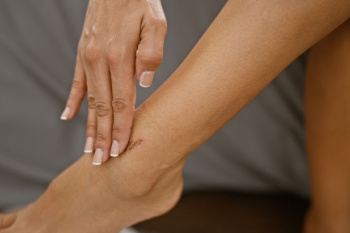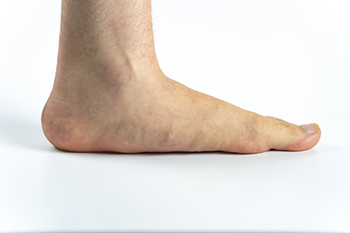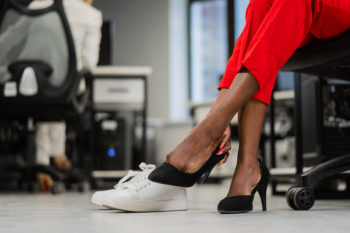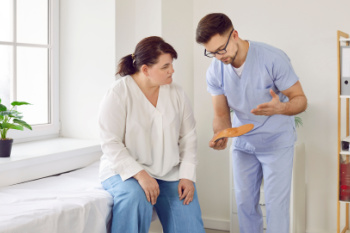Items filtered by date: July 2025
Corns on the Feet Are Small Bumps That Can Cause Big Discomfort

Corns are thickened areas of skin that develop on the feet due to repeated pressure or friction, often from tight shoes, high heels, or abnormal gait. They commonly form on the top and sides of toes or the soles of the feet. Corns may appear as hard, raised bumps surrounded by inflamed skin. They can feel rough to the touch and may cause tenderness or a burning sensation, especially when walking or wearing shoes. While over-the-counter remedies exist, improper removal can lead to infection or worsening symptoms. A podiatrist can safely remove corns, assess for underlying causes like misaligned toes or poor footwear, and recommend treatments such as custom orthotics, padding, or changes in footwear to prevent recurrence. If corns are interfering with your comfort or mobility, it is suggested that you make an appointment with a podiatrist.
If you have any concerns regarding your feet and ankles, contact one of our podiatrists of Foot and Ankle Reconstruction of Georgia. Our doctors will treat your foot and ankle needs.
Corns: What Are They? and How Do You Get Rid of Them?
Corns can be described as areas of the skin that have thickened to the point of becoming painful or irritating. They are often layers and layers of the skin that have become dry and rough, and are normally smaller than calluses.
Ways to Prevent Corns
There are many ways to get rid of painful corns such as wearing:
- Well-fitting socks
- Comfortable shoes that are not tight around your foot
- Shoes that offer support
Treating Corns
Treatment of corns involves removing the dead skin that has built up in the specific area of the foot. Consult with Our doctors to determine the best treatment option for your case of corns.
If you have any questions, please feel free to contact our offices located in Woodstock, Jasper, and Marietta, GA . We offer the newest diagnostic and treatment technologies for all your foot care needs.
When to Seek Help for Chronic Foot Wounds

Some foot wounds do not heal as expected and may linger for weeks or even months. These are considered chronic and can result from poor circulation, diabetes, nerve damage, or repeated pressure on one area. Often, they begin as small cuts, blisters, or sores that fail to close and may become red, swollen, or develop drainage. Left untreated, chronic wounds can lead to infection and more serious complications. This is especially concerning for individuals with diabetes or reduced sensation in the feet, who may not feel the injury worsening. Proper wound care, offloading pressure, and treating any underlying conditions are key to recovery. In many cases, advanced therapies or podiatrists are needed to encourage healing. If you have a foot wound that has not improved within two weeks or seems to be getting worse, it is suggested that you see a podiatrist for a full evaluation and appropriate treatment.
Wound care is an important part in dealing with diabetes. If you have diabetes and a foot wound or would like more information about wound care for diabetics, consult with one of our podiatrists from Foot and Ankle Reconstruction of Georgia. Our doctors will assess your condition and provide you with quality foot and ankle treatment.
What Is Wound Care?
Wound care is the practice of taking proper care of a wound. This can range from the smallest to the largest of wounds. While everyone can benefit from proper wound care, it is much more important for diabetics. Diabetics often suffer from poor blood circulation which causes wounds to heal much slower than they would in a non-diabetic.
What Is the Importance of Wound Care?
While it may not seem apparent with small ulcers on the foot, for diabetics, any size ulcer can become infected. Diabetics often also suffer from neuropathy, or nerve loss. This means they might not even feel when they have an ulcer on their foot. If the wound becomes severely infected, amputation may be necessary. Therefore, it is of the upmost importance to properly care for any and all foot wounds.
How to Care for Wounds
The best way to care for foot wounds is to prevent them. For diabetics, this means daily inspections of the feet for any signs of abnormalities or ulcers. It is also recommended to see a podiatrist several times a year for a foot inspection. If you do have an ulcer, run the wound under water to clear dirt from the wound; then apply antibiotic ointment to the wound and cover with a bandage. Bandages should be changed daily and keeping pressure off the wound is smart. It is advised to see a podiatrist, who can keep an eye on it.
If you have any questions please contact our offices located in Woodstock, Jasper, and Marietta, GA . We offer the newest diagnostic and treatment technologies for all your foot and ankle needs.
Arthritis Can Cause Pain in the Feet and Ankles
How a Podiatrist Can Help People With Flat Feet

Flat feet, also known as fallen arches, occur when the arches of the feet collapse, causing the entire sole to touch the ground. This condition can be present from birth or develop over time due to injury, aging, obesity, or certain medical conditions. Symptoms include foot pain, swelling, fatigue, or difficulty standing or walking for long periods. Some people experience knee or back discomfort as well. Relief often comes from wearing supportive shoes, custom orthotics, or stretching exercises. A podiatrist can evaluate the structure of your feet, identify the underlying cause, and recommend a personalized treatment plan. If you have flat feet and have persistent foot pain, it is suggested that you consult a podiatrist for effective relief and improved foot function.
Flatfoot is a condition many people suffer from. If you have flat feet, contact one of our podiatrists from Foot and Ankle Reconstruction of Georgia. Our doctors will treat your foot and ankle needs.
What Are Flat Feet?
Flatfoot is a condition in which the arch of the foot is depressed and the sole of the foot is almost completely in contact with the ground. About 20-30% of the population generally has flat feet because their arches never formed during growth.
Conditions & Problems:
Having flat feet makes it difficult to run or walk because of the stress placed on the ankles.
Alignment – The general alignment of your legs can be disrupted, because the ankles move inward which can cause major discomfort.
Knees – If you have complications with your knees, flat feet can be a contributor to arthritis in that area.
Symptoms
- Pain around the heel or arch area
- Trouble standing on the tip toe
- Swelling around the inside of the ankle
- Flat look to one or both feet
- Having your shoes feel uneven when worn
Treatment
If you are experiencing pain and stress on the foot you may weaken the posterior tibial tendon, which runs around the inside of the ankle.
If you have any questions, please feel free to contact our offices located in Woodstock, Jasper, and Marietta, GA . We offer the newest diagnostic and treatment technologies for all your foot care needs.
The Impact of High Heels on Foot Health

Wearing high heels regularly can significantly affect foot structure and movement. Heels alter natural gait, forcing the body to lean forward and placing excess pressure on the ball of the foot. This unnatural position can lead to pain, calluses, and long-term joint stress. High heels also create ankle instability, increasing the risk of sprains or fractures from sudden twists or missteps. Over time, frequent use may lead to chronic foot discomfort and toe deformities. A podiatrist can evaluate foot health, provide relief strategies, and recommend supportive footwear alternatives. If you experience foot pain from wearing heels, it is suggested that you seek guidance from a podiatrist to restore comfort, improve balance, and protect your feet from further damage or injury.
High heels have a history of causing foot and ankle problems. If you have any concerns about your feet or ankles, contact one of our podiatrists from Foot and Ankle Reconstruction of Georgia. Our doctors can provide the care you need to keep you pain-free and on your feet.
Effects of High Heels on the Feet
High heels are popular shoes among women because of their many styles and societal appeal. Despite this, high heels can still cause many health problems if worn too frequently.
Which Parts of My Body Will Be Affected by High Heels?
- Ankle Joints
- Achilles Tendon – May shorten and stiffen with prolonged wear
- Balls of the Feet
- Knees – Heels cause the knees to bend constantly, creating stress on them
- Back – They decrease the spine’s ability to absorb shock, which may lead to back pain. The vertebrae of the lower back may compress.
What Kinds of Foot Problems Can Develop from Wearing High Heels?
- Corns
- Calluses
- Hammertoe
- Bunions
- Morton’s Neuroma
- Plantar Fasciitis
How Can I Still Wear High Heels and Maintain Foot Health?
If you want to wear high heeled shoes, make sure that you are not wearing them every day, as this will help prevent long term physical problems. Try wearing thicker heels as opposed to stilettos to distribute weight more evenly across the feet. Always make sure you are wearing the proper shoes for the right occasion, such as sneakers for exercising. If you walk to work, try carrying your heels with you and changing into them once you arrive at work. Adding inserts to your heels can help cushion your feet and absorb shock. Full foot inserts or metatarsal pads are available.
If you have any questions, please feel free to contact our offices located in Woodstock, Jasper, and Marietta, GA . We offer the newest diagnostic and treatment technologies for all your foot care needs.
How Shoes Should Fit to Support Foot Health

Wearing shoes that fit properly is essential for keeping feet comfortable and preventing injury. A well-fitting shoe allows enough space at the front so toes can move freely without rubbing. There should be about a thumb’s width between the longest toe and the end of the shoe. The heel should sit securely without slipping, and the sides should feel snug, but not tight. Arch support should match the shape of your foot to help with balance and reduce strain. Shoes that are too tight can increase the risk of blisters, bunions, or ingrown toenails, while shoes that are too loose may cause instability or falls. Measuring both feet and trying on shoes at the end of the day, when feet are slightly swollen, can help ensure the best fit. If you have developed foot pain from wearing shoes that do not fit correctly, or have concerns about your shoe fit or foot comfort, it is suggested that you consult a podiatrist for expert advice.
Getting the right shoe size is an important part of proper foot health. Seek the assistance of one of our podiatrists from Foot and Ankle Reconstruction of Georgia. Our doctors will provide the care you need to keep you pain-free and on your feet.
Getting the Right Shoe Size
There are many people who wear shoes that are the incorrect size, negatively affecting their feet and posture. Selecting the right shoes is not a difficult process, so long as you keep several things in mind when it comes to choosing the right pair.
- When visiting the shoe store, use the tools available to measure your foot.
- Be sure there is ‘wiggle room’. There should be about an inch between your toes and the tip of your shoes.
- Do not always assume you are the same size, as manufacturers run differently.
- Purchase shoes later in the day, as your feet swell as the day progresses.
- If a shoe is not comfortable, it is not suitable. Most shoes can’t be ‘broken in’, and comfort should be the ultimate goal when it comes to choosing the right pair of shoes
As our feet hold our body weight and keep us moving, it is important to treat them right. Picking the right pair of shoes can provide your feet comfort and mobility without pain.
If you have any questions, please feel free to contact our offices located in Woodstock, Jasper, and Marietta, GA . We offer the newest diagnostic and treatment technologies for all your foot care needs.

